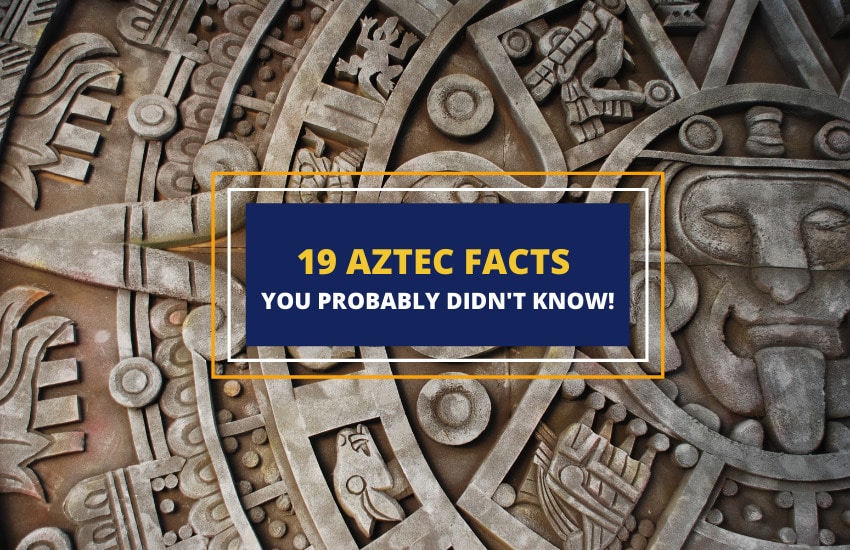
Table of Contents
The history of the Aztecs is a history of a glorious development of a group of people into a bustling civilization. The Aztec Empire encompassed Mesoamerica and was washed by the shores of two oceans.
This mighty civilization was known for its complex societal fabric, a highly developed religious system, lively trade, and sophisticated political and legal system. However, although the Aztecs were fearless warriors, they were not able to overcome the troubles that came with imperial overstretch, internal turmoil, disease, and Spanish colonialism.
This article covers 19 interesting facts about the Aztec empire and its people.
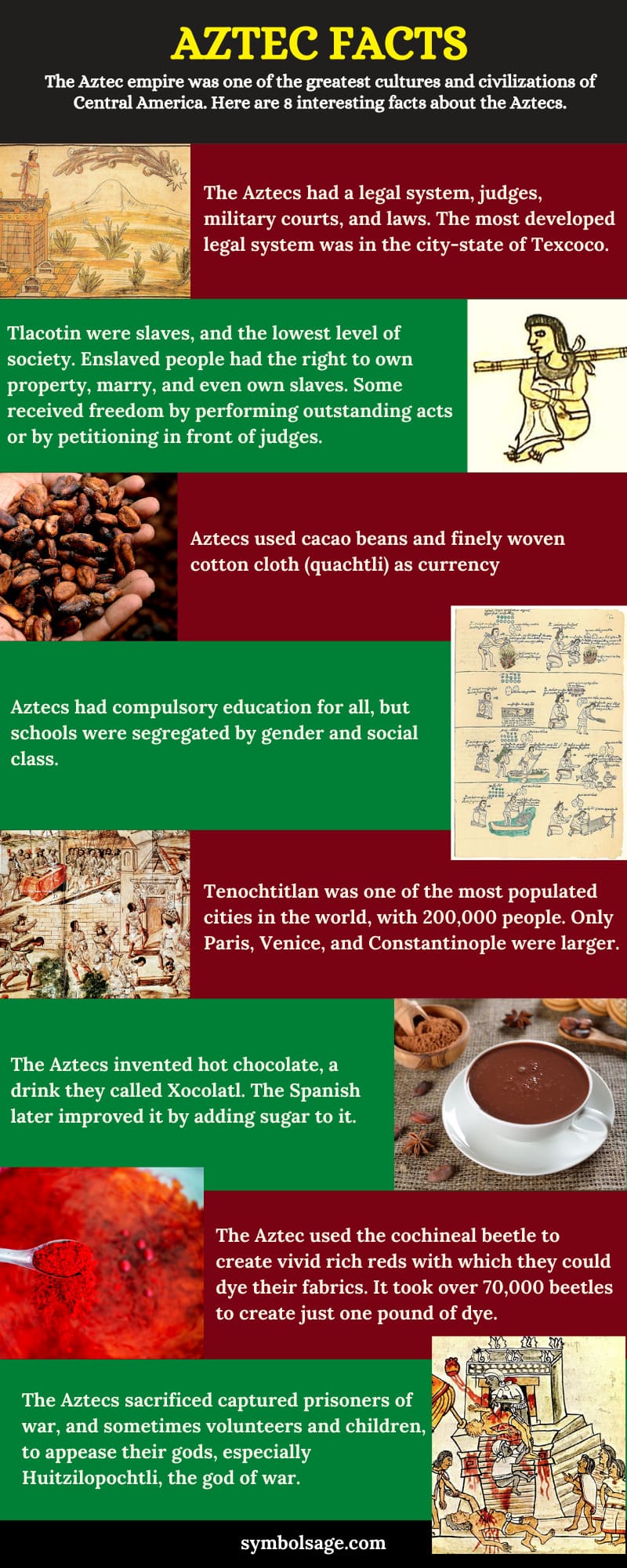
1- The Aztecs didn’t call themselves Aztecs.
Today, the word Aztec is used to describe the people that lived in the Aztec Empire, a triple alliance of three city-states, who were predominantly Nahua people. These people lived in the area of what we know today as Mexico, Nicaragua, El Salvador, and Honduras, and used the Nahuatl language. They called themselves the Mexica or the Tenochca.
In the Nahuatl language, the word Aztec was used to describe the people that came from Aztlan, a mythical land from which the Nahua people that formed the empire claimed to have come from.
2- The Aztec Empire was a confederation.
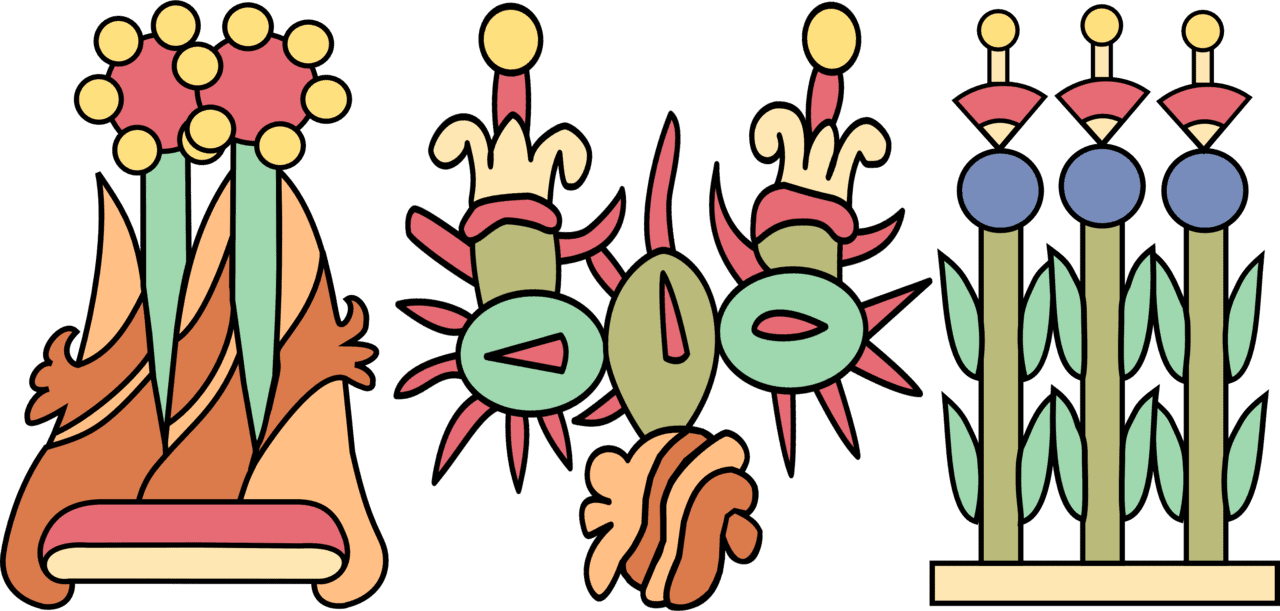
The Aztec empire was an example of an early confederation, as it was made up of three different city-states called altepetl. This triple alliance was made of Tenochtitlan, Tlacopan, and Texcoco. This was established in 1427. However, during most of the empire’s life, Tenochtitlan was by far the strongest military power in the region and as such – the de facto capital of the confederation.
3- The Aztec Empire had a short run.

The empire was conceived in 1428 and had a promising start, however, it would not live to see its centenary because the Aztecs discovered a new force that stepped foot on their land. The Spanish conquistadors came to the region in 1519 and this marked the beginning of the end of the Aztec empire that would eventually collapse in 1521. However, during this short time, the Aztec empire rose to become one of the greatest civilizations of Mesoamerica.
4- The Aztec Empire was similar to an absolute monarchy.

The Aztec Empire can be compared to an absolute monarchy by today’s standards. Over the period of the empire, nine different emperors ruled one after the other
Interestingly, every city-state had its own ruler called Tlatoani which means He Who Speaks. Over time, the ruler of the capital city, Tenochtitlan, became the emperor that spoke for the entire empire, and he was called Huey Tlatoani which can be loosely translated as the Great Speaker in the Nahuatl language.
The emperors ruled over the Aztecs with an iron fist. They considered themselves to be descendants of gods and that their rule was enshrined in divine right.
5- The Aztecs believed in more than 200 gods.

Although many of the Aztec beliefs and myths can only be traced back the writings of the Spanish colonizers in the 16th century, we know that the Aztecs nurtured a very complex pantheon of gods.
So how did the Aztecs keep track of their many deities? They divided them into three groups of deities that took care of certain aspects of the universe: sky and rain, war and sacrifice, and fertility and agriculture.
Aztecs were a part of a larger group of Nahua people, so they shared many deities with other Mesoamerican civilizations, which is why some of their gods are considered pan-Mesoamerican gods.
The most important god in the Aztec pantheon was Huitzilopochtli, who was the creator of the Aztecs and their patron god. It was Huitzilopochtli who told the Aztecs to establish a capital city in Tenochtitlan. Another major god was Quetzalcoatl, the feathered serpent, the god of the sun, wind, air and of learning. In addition to these two major deities, there were around two hundred more.
6- Human sacrifice was an important part of the Aztec culture.

Although human sacrifice was practiced in many other Mesoamerican societies and cultures hundreds of years before the Aztecs, what truly differentiates the Aztec practices is how important human sacrifice was for everyday life.
This is a point that historians, anthropologists, and sociologists still debate strongly. Some claim that human sacrifice was a fundamental aspect of the Aztec culture and should be interpreted in the wider context of the pan-Mesoamerican practice.
Others would tell you that human sacrifice was performed to appease various gods and should be regarded as nothing more than that. The Aztecs believed that during moments of great societal turbulences, like pandemics or droughts, ritual human sacrifices should be performed to appease the gods.
Aztecs believed that all gods sacrificed themselves once to protect humanity and they called their human sacrifice nextlahualli, which means repaying debt. The Aztec god of war, Huitzilopochtli, was frequently offered human sacrifices from enemy warriors. The mythos surrounding the possible end of the world if Huitzilopochtli wasn’t “fed” captured enemy warriors meant that the Aztecs continuously waged war against their enemies.
7- Aztecs did not only sacrifice humans.
Humans were sacrificed for some of the most important gods of the pantheon. Those like Toltec or Huitzilopochtli were most revered and feared. For other gods, Aztecs would regularly sacrifice dogs, deer, eagles, and even butterflies, and hummingbirds.
8- Warriors used human sacrifice as a form of class rise.
On top of Templo Mayor, a captured soldier would be sacrificed by a priest, who would use an obsidian blade to cut into the abdomen of the soldier and rip out his heart. This would then be lifted towards the sun and offered to Huitzilopochtli.
The body would be ritually thrown down the stairs of the great pyramid, where the warrior who had captured the sacrificed victim would wait. He would then offer pieces of the body to important members of the society or for ritual cannibalism.
Performing well at battle enabled warriors to rise higher in rank and increase their status.
9- Children were sacrificed for rain.
Standing tall next to the great pyramid of Huitzilopochtli was the pyramid of Tlaloc, the god of rain and thunder.
The Aztecs believed that Tlaloc brought rain and sustenance and therefore he had to be regularly appeased. The tears of children were believed to be the most appropriate form of appeasement for Tlaloc, so they would be ritually sacrificed.
Remains of over 40 children have been found in recent salvage excavations, showing signs of great suffering and severe injuries.
10- The Aztecs developed a complex legal system.
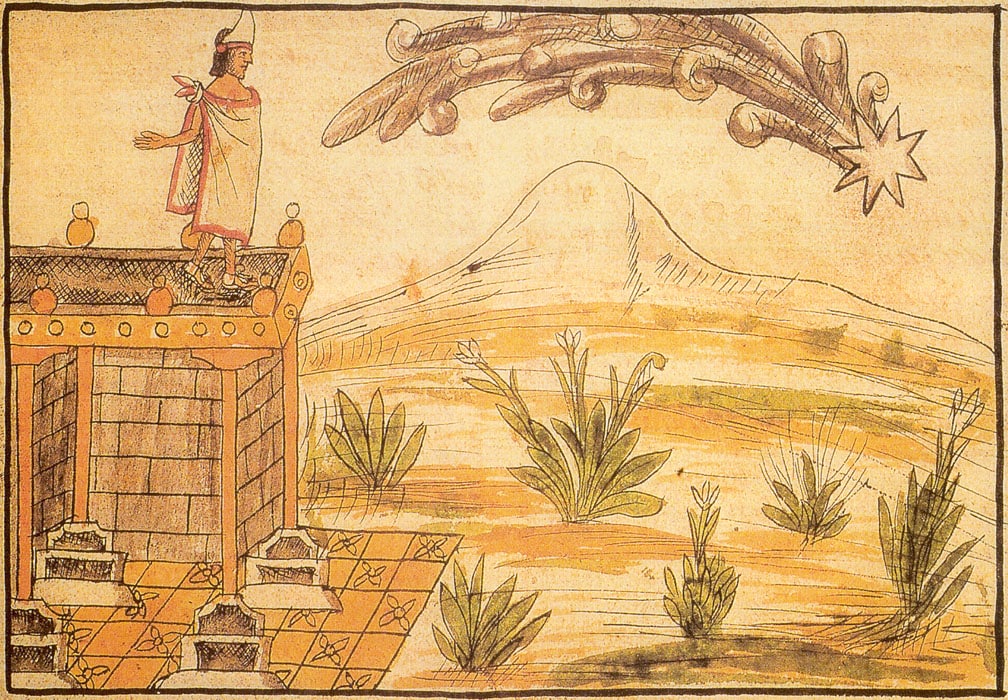
Everything we know today about the Aztec legal systems comes from the colonial-era writings of the Spanish.
The Aztecs had a legal system, but it varied from one city-state to the other. The Aztec empire was a confederation, so city-states had more powers to decide the legal state of affairs over their territories. They even had judges and military courts. Citizens could start an appeal process at various courts and their case could eventually end before the Supreme Court.
The most developed legal system was in the city-state of Texcoco, where the city ruler developed a written code of law.
Aztecs were severe and practiced public administration of punishments. In Tenochtitlan, the capital of the empire, a somewhat less sophisticated legal system emerged. Tenochtitlan lagged behind other city-states, and it was not before Moctezuma I that a legal system would be established there as well.
Moctezuma I, tried to criminalize public acts of drunkenness, nudity, and homosexuality, and more severe crimes like theft, murder, or the damage of property.
11- The Aztecs developed their own system of slavery.
Enslaved people, or tlacotin as they were called in the Nahuatl language, constituted the lowest class of the Aztec society.
In Aztec society, slavery was not a social class that one could be born into, but instead occurred as a form of punishment or out of financial desperation. It was even possible for widowed women who were slave-owners to marry one of their slaves.
According to the Aztec legal system, almost anyone could become a slave meaning that slavery was a very complex institution that touched every part of the society. A person could enter slavery voluntarily. Unlike other parts of the world, here, enslaved people had the right to own property, marry, and even own slaves of their own.
Freedom was attained by performing outstanding acts or by petitioning for it in front of judges. If a person’s petition was successful, they would be washed, given new clothes, and declared free.
12- The Aztecs practiced polygamy.
The Aztecs were known to practice polygamy. They were legally allowed to have multiple wives but only the first marriage was celebrated and ceremonially marked.
Polygamy was a ticket for climbing up the societal ladder and increasing one’s visibility and power because it was commonly believed that having a larger family also meant having more resources and more human resource.
When the Spanish conquistadors came and introduced their own government, they did not recognize these marriages and only recognized the first official marriage between a couple.
13- Aztecs traded in cacao beans and cotton cloth instead of money.
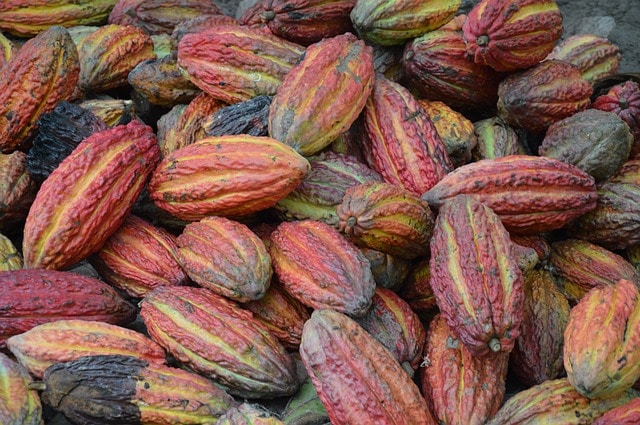
The Aztecs were known for their robust trade that went on uninterrupted by wars and other societal developments.
The Aztec economy was heavily dependent on agriculture and farming, so it comes as no surprise that Aztec farmers grew a lot of different fruits and vegetables among which were tobacco, avocado, peppers, corn, and cacao beans. The Aztecs enjoyed meeting in large marketplaces, and it is reported that up to 60,000 people would circulate daily through big Aztec marketplaces.
Rather than using other forms of money, they would exchange cacao beans for other goods and the higher the quality of the bean, the more valuable it was to trade. They also had another form of currency called Quachtli, made of finely woven cotton cloth that was worth up to 300 cacao beans.
14- Aztecs had compulsory schooling.

Education was very important in Aztec society. To be educated meant having the tools for survival and being able to climb up the social ladder.
Schools were open to pretty much everyone. However, it is worthy to know that the Aztecs had a segregated education system, where schools were divided by gender and by social class.
Children of the nobility would be taught higher sciences like astronomy, philosophy, and history, while the children from lower classes would be trained in trade or warfare. On the other hand, girls would be typically educated on how to take care of their homes.
15- The Aztecs considered chewing gum inappropriate.
Although there is a debate whether it was the Mayans or the Aztecs who invented chewing gum, we know that chewing gum was popular among the Mesoamericans. It was created by slicing the bark of a tree and collecting the resin, which would then be used for chewing or even as a breath freshener.
Interestingly, the Aztecs frowned upon adults who would chew gum in public, especially women, and deemed it socially unacceptable and inappropriate.
16- Tenochtitlan was the third most populated city in the world.
The capital of the Aztec empire, Tenochtitlan was at the height of its population numbers around the early 16th century. The exponential growth of Tenochtitlan and the rising population made it the third biggest city in the world in terms of population. By 1500, the population reached 200,000 people and at the time, only Paris and Constantinople had larger populations than Tenochtitlan.
17- The Spanish used the Aztecs dissatisfaction to crush their own empire.
The Spanish encountered the Aztec Empire around 1519. They arrived just as the society was facing internal turmoil, because subdued tribes were not happy with having to pay taxes and provide sacrificial victims to Tenochtitlan.
By the time the Spanish came, there was heavy resentment within the society, and it was not hard for Hernán Cortés to exploit this internal turmoil and turn the city-states against one another.
The last emperor of the Aztec Empire, Moctezuma II, was captured by the Spanish and imprisoned. During the whole affair, the markets remained closed, and the population rioted. The empire started crumbling under Spanish pressure and turned on itself. The enraged people of Tenochtitlan were described as being so disenfranchised with the emperor that they stoned him and threw spears at him.
This is only one account of Moctezuma’s death, other accounts state that he died at the hands of the Spanish.
18- The Europeans brought disease and illness to the Aztecs.
When the Spanish invaded Mesoamerica, they brought with them smallpox, mumps, measles, and many other viruses and diseases that had never been present in Mesoamerican societies.
Given the lack of immunity, the Aztec population slowly started to decrease, and the number of deaths skyrocketed all over the Aztec Empire.
19- Mexico City was built on the ruins of Tenochtitlan.
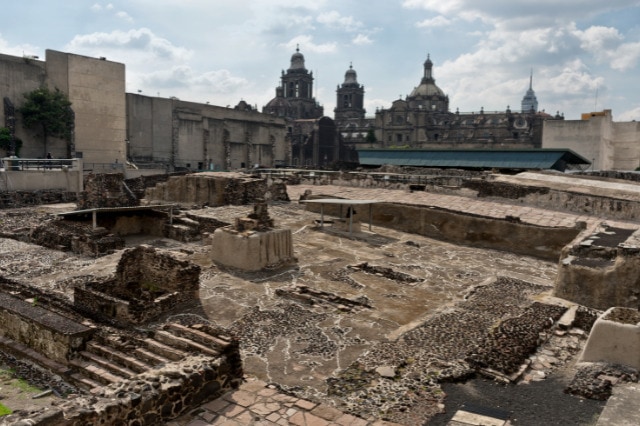
Modern-day map Mexico City was built on the remains of Tenochtitlan. With the Spanish invasion of Tenochtitlan on August 13, 1521, around 250,000 people were killed. It did not take the Spanish too long to destroy Tenochtitlan and build Mexico City on top of its ruins.
Not long after it was established, Mexico City became one of the centers of the newly discovered world. Some ruins of old Tenochtitlan can still be found in the center of Mexico City.
Wrapping Up
One of the greatest civilizations, the Aztec empire introduced was greatly influential during its time. Even today, it’s legacy continues in the form of many inventions, discoveries, and engineering feats that still continue to be impactful. To learn more about the Aztec empire, go here. If you are interested in Aztec symbols, check out our detailed articles.








